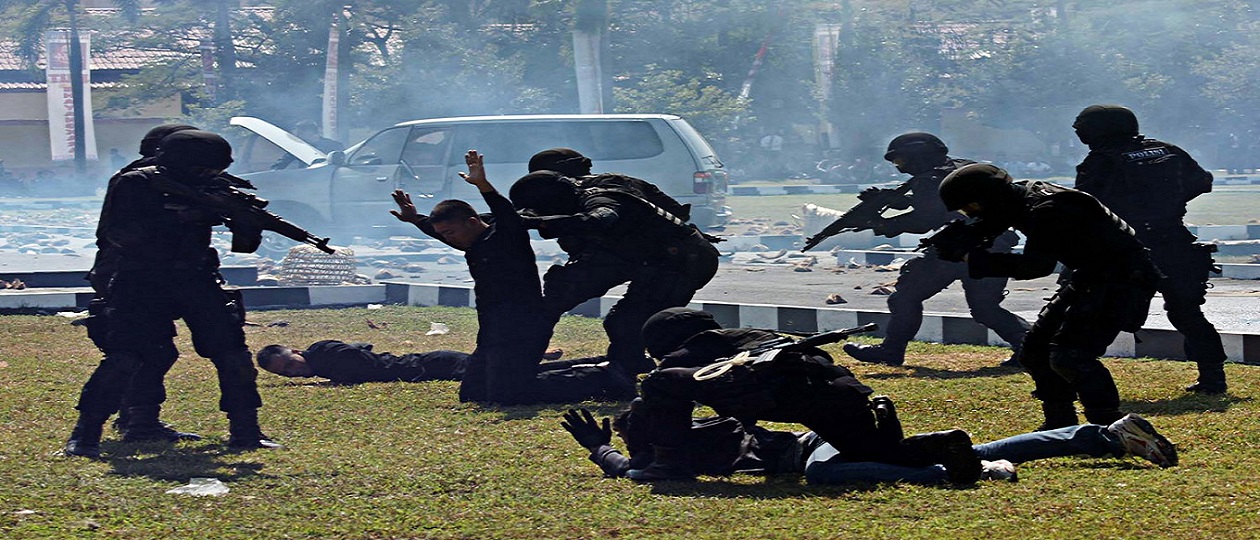
Defining terrorism and showing how terrorism is different from other types of political violence is becoming more different in our age of information overload.
Information Overload about Terrorism in Today’s World
Terrorism is part of everyday life in many parts of today’s world. Print and broadcast media keep us informed about terrorist attacks everywhere.
Since the Al-Qaida terrorist attacks in the United States on September 11, 2001, many academic and popular books have been published about terrorism. Government and intergovernmental Internet sites have lists of groups considered terrorist and describe intergovernmental actions in fighting terrorism.
There is no single source comprehensively analyzing terrorism in the past and present. One ambitious attempt to list and categorize terrorist acts is the Global Terrorism Database from the University of Maryland. The database lists more than 200,000 terrorist acts between 1970-2020. Researchers can search by country, terrorist group, region, weapon type, target type, and other categories.
Summary and comprehensive books about terrorism attempt to track its history in different regions. For example, the book Chronologies of modern terrorism uses regional and thematic categories to track the history of terrorism. The categories are:
- The early history of terrorism as an ideology and strategy.
- Social-revolutionary terrorism in Europe and North America.
- Nationalist terrorism in Europe and North America.
- Social-revolutionary terrorism in Latin America.
- Revolutionaries of Asia and Africa.
- Terrorism in the Near East.
- Radical Islamic terrorism.
- The Global Jihad, September 11, 2001, and afterwards.
Despite all the information that we have about terrorism, too often we don’t exactly know what terrorism is and what makes it different from other types of political violence. Let’s look at some of the reasons why we have this problem.
The topic of this article has a high degree of relevance because the history of political terrorism in the Russian Empire is still badly integrated into the history of European and world terrorism.
Sarcasm and Relativity
We often hear the expression <<one person’s terrorist is another person’s freedom fighter. >> There is a certain amount of truth in this expression because terrorists often claim that they are freedom fighters and not murderers. American President Ronald Reagan once said that this sarcastic expression about terrorists and freedom fighters was a major obstacle to effective counterterrorism on a global scale. But we must remember the context of Reagan’s words. The president called the Soviet Union an evil empire and accused the Soviet government of sponsoring international terrorism.
Politicizing the Terrorism Issue
The 1980s was the last decade of the Cold War and included a polemical publishing war between the United States and the Soviet Union about terrorism. American journalist Claire Sterling and several Western journalists and political scientists accused the Soviet Union in leadership of international terrorism as a means of destabilizing Western countries. Soviet publicists answered back by saying that the Americans sponsored Trotskyite, Maoist, anarchist, and other ultra-left groups that objectively served the interests of American imperialism and neofascism. Both American and Soviet publicists accused each other of using an alliance of far-right and far-left terrorist organizations to meet their foreign policy goals. Soviet publicists followed a selective approach in deciding which groups were terrorist. For example, they regarded groups such as West Germany’s Red Army Fraction and Italy’s Red Brigades, but their books did not mention organizations like the Palestine Liberation Organization and the Irish Republican Army which were considered <<national-liberation movements>>. Very few of the polemical works published by both sides had any scholarly value.
Somewhat curiously, both American and Soviet publicists gave examples from pre-revolutionary Russian terrorism. Sterling suggested that contemporary left-wing terrorists borrowed organizational tactics from Russian revolutionaries. Soviet publicists emphasized that left-wing terrorists in Europe, Latin America, and other regions were repeating the same mistakes made by Russian terrorists in choosing terrorism as a means of political struggle. In this case, journalists and publicists were using history to support foreign policy issues in the present.
Ideological tendencies in terrorist organizations can vary according to the country, region, or historical period. Terrorism in the Russian Empire was overwhelming left-wing with Empire-wide socialist parties, ethnic minority socialist parties, and anarchist groups committing terrorist acts. Sometimes today, we can get the impression that terrorist organizations are from only one ideological tendency. For example, the American-based Southern Poverty Law Center focuses on right-wing extremism from white racists, Christian fundamentalists, and conspiratorial movements. Including these groups and ideologies in the list of extremists suggests that their followers form the base of actual and possible terrorists because they have gone through the process of radicalization. One would have to check other sources to find out about left-wing and other types of terrorism to get a full picture of terrorism and extremism in the United States.
Personal political tendencies or preferences cannot give us the right to determine which organizations are terrorist and which ones are not.
Terminology Issues
As noted in the previous article, terrorism and terror are two different things. Governments practice terror as a form of violence against their real or imagined opponents while opposition groups practice terrorism against their opponents from governments and society. However, too many authors blur the distinction between state terror and oppositional terrorism. The term state terrorism is often used to describe the state terror of Nazism, Stalinism, Fascism, and other extreme ideologies.
Using trendy terms also does not help us understand what terrorism is. For example, Brazilian Communist Carlos Marighella in the late 1960s called terrorist urban guerillas. Guerilla is the Spanish word for little war and refers to the partisan warfare that Spaniards conducted against the French invaders in the early 19th century. Partisans or guerillas in all wars try to control rural or countryside areas and they sometimes use terrorism against enemies. It is completely impossible for partisans to occupy parts of cities because of the high presence of police and the armed forces. The term urban guerilla may be fashionable, but it is inaccurate to call terrorists urban guerillas.
Some scholars consider terrorism a form of violent extremism. Extremists are regarded as people who hold extremist political beliefs and who have undergone the process of radicalization. People go through this process by accepting radical or extremist views. Extremism expresses itself through violent or nonviolent political activity. Once again, we are dealing with terminology. For example, the American-based Counter Extremism project focuses on Islamist and far right and Islamist extremist movements and on the role of Internet social media in radicalizing people.
New Varieties of Terrorism
What makes it difficult to place terrorism in the Russian Empire within the history of European and world terrorism is that there are so many varieties of terrorism that simply had no equivalent in pre-1914 Russia and Europe. These variations include: state-sponsored terrorism — when governments use terrorist groups to destabilize other governments; terrorism as a form of proxy war between states; rogue or failed states using terrorism to destabilize their enemies, governments using death squads to destroy their enemies, piracy on the seas, cyberterrorism to destroy computer infrastructure, narco-terrorism — establishment of financial alliances between terrorists and narcotics dealers; terrorists using chemical and biological weapons of mass destruction, eco-terrorism — terrorism used by environmental groups and animal rights organizations. Gender terrorism also exists especially in the <<involuntary celibates>> movement <<Invols>> are men who have failed to establish relationships with women, and they conduct terrorist attacks specifically against women.
Some of today’s trends in terrorism had their roots before 1914. Terrorists in Russia and Europe sometimes considered poisoning city water supplies or throwing bombs from airplanes.
Alongside today’s terrorist movements, there are also many violent political protest movements. These include the <<yellow vests>> in France and other countries, the Occupy movements, anti-austerity movements in the European Union, paramilitary groups, armed political bands, and certain groups in the Make America Great Again movement. Often these movements carry out actions against traditional political parties and even against new political parties. Of course, there is always the possibility that these protest movements can either evolve into organized эволюционировать в организованные политические партии or into terrorist movements.
Terminology once again blurs the distinction between terrorism and other types of political mass violence. Scholars often include terrorists under the classification of <<non-state armed actors>> and call terrorism a form of <<asymmetrical warfare>> or <<irregular warfare>> — war that is not conducted by conventional armies. Non-state actors can include terrorists, partisan or guerilla organizations, insurgent organizations, armed bands of political parties, private militias, paramilitary formations, and mercenaries. These categories can give us some idea of the varieties of political violence, but the problem remains in determining which organizations are terrorist and which are not terrorist.
The next article will look at why it is difficult to fit Russian terrorism into the history of European terrorism beginning in the 19th century and continuing right up to the present. Prerevolutionary Russian terrorism definitely foreshadowed many trends in European terrorism.
Citations
- Global Terrorism Database https://www.start.umd.edu/gtd/
- Rubin, Barry and Judith Colp Rubin. Chronologies of modern terrorism. Armonk, NY: M.E. Sharpe, 2008.
- Reagan, Ronald. Radio Address to the Nation on Terrorism. May 31, 1986. https://www.reaganlibrary.gov/research/speeches/53186a
- Sterling, Claire. The terror network: the secret war of international terrorism. New York: Holt, Rhinehart, and Winston, 1981.
- For example, Витюк В.В., С.А. Эфиров. “Левый” терроризм на Западе: история и современность. (So called Left terrorism in the West: past and presentМосква: Наука, 1987; Генри, Эрнст. Против терроризма. (Against Terrorism) Москва: Издательство Агентства печати Новости, 1981; Грачев, А. С. Тупики политического насилия: экстремизм и терроризм на службе международной реакции. (Dead ends of political violence: extremism and terrorism at the service of international reaction). Москва: Международные отношения, 1982.
- Southern Poverty Law Center. Extremist Files. Groups https://www.splcenter.org/fighting-hate/extremist-files/groups
- Rocchi, T. Terrorism in the Russian Empire: Lessons of history for today’s war on terrorism. Part I: posing the questions for studying terrorism in Russia //Historical and Social-Educational Idea Volume 10 #5/1, 2018, pp. 36-52. //Рокки, Т. Терроризм в Российской империи: уроки истории для сегодняшней войны против терроризма. Часть I; постановка вопросов к изучению терроризма в России // Историческая и социально-образовательная мысль. Toм 10 № 5/1, 2018, сс. 36-52. https://cyberleninka.ru/article/n/terrorism-in-the-russian-empire-lessons-of-history-for-todays-war-on-terrorism-part-i-posing-the-questions-for-studying-terrorism-in-russia
- Marighella, Carlos. Minimanual of the Urban Guerilla. June, 1969. https://www.marxists.org/archive/marighella-carlos/1969/06/minimanual-urban-guerrilla/index.htm
- Counter Extremism Project https://www.counterextremism.com





